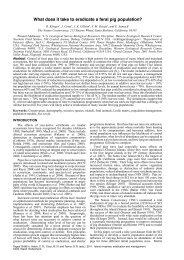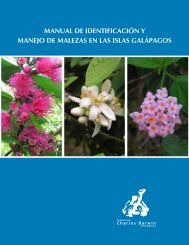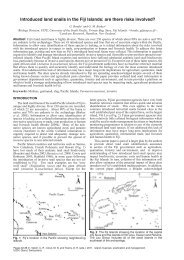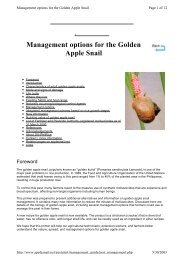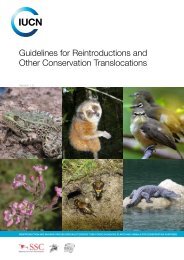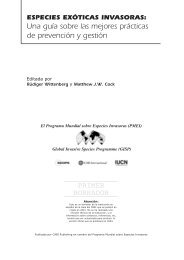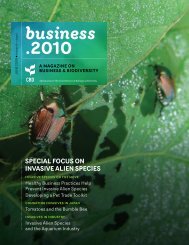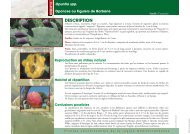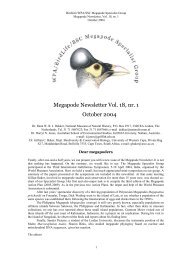Aliens Newsletter - ISSG
Aliens Newsletter - ISSG
Aliens Newsletter - ISSG
Create successful ePaper yourself
Turn your PDF publications into a flip-book with our unique Google optimized e-Paper software.
tensified predation by M. salmoides and thus a temporary<br />
crash in the density of the crayfish population<br />
(Hickley et al. 1994; Hickley & Harper 2002).<br />
A cycle of plant recovery due to the P. clarkii decline,<br />
followed by a build-up of crayfish densities<br />
and then by new plant decline, seemed to have established<br />
by the early 1990s (Harper 1992). By the<br />
mid 1990s, however, water hyacinth Eichhornia<br />
crassipes, another alien first appeared in 1988, had<br />
produced dense littoral and floating mats that offered<br />
a permanent refuge for P. clarkii. This protection<br />
from predation allowed high recruitment in the<br />
crayfish population (Harper et al. 2002; Smart et al.<br />
2002; Ngari et al. 2009) until November 2000, when<br />
an unexpected decline was again recorded. This new<br />
crash was seemingly caused by the break-up of E.<br />
crassipes mats due to the hyacinth weevil, Cyrtobagus<br />
eichhorniae, introduced to control water hyacinth<br />
by the Kenya Agricultural Research Institute<br />
(KARI) first in 1996 and again in 1999. During the<br />
last decade, submerged macrophytes and P. clarkii,<br />
as well as E. crassipes and C. eichhorniae populations,<br />
were subject to unstable oscillations as a consequence<br />
of the domination of the omnivorous C.<br />
carpio (Britton et al. 2007). Finally, in 1999 P.<br />
clarkii appeared in the two perennial lake tributaries,<br />
the Malewa and the Gilgil, where it is currently<br />
spreading (Figure 3); its first arrival being possibly<br />
due to either natural upstream movements<br />
and/or human introduction to control leeches (Foster<br />
& Harper 2006). In the rivers, P. clarkii poses<br />
threat to the indigenous river crab Potamonautes<br />
loveni (Foster & Harper 2006) and replaces crabs<br />
as the primary food item for the African clawless<br />
otter, Aonyx capensis (Ogada et al. 2009).<br />
Alien species now dominate each main level of the<br />
lake’s foodweb; in this respect Lake Naivasha is one<br />
of the best studied examples of an alien-driven<br />
ecosystem. The main primary producer in the littoral<br />
is E. crassipes together with Salvinia molesta, first<br />
recorded in the lake in 1961 (Hubble & Harper<br />
2000). The red swamp crayfish is a voracious omnivore,<br />
with a diet including terrestrial plants from<br />
the lake edge, detritus, and benthic invertebrates<br />
(Harper et al. 2002). The carp is a bottom-grubber<br />
(Britton et al. 2007), acting both as a competitor and<br />
as a predator of P .clarkii. Only at the top of the<br />
foodweb are indigenous predators, birds such as cormorants,<br />
fish eagles, grebes, and ibises.<br />
The combination of the impacts caused by alien species,<br />
physical degradation of riparian habitats, and decrease<br />
in water level induced a switch from moderately to<br />
highly eutrophic conditions. The 1990s phytoplankton<br />
community, strongly dominated by a persistent population<br />
of the diatom Aulacoseira italica, was replaced<br />
from 2005 onwards by frequent blooms of the<br />
cyanobacterium Microcystis sp. (Harper et al. 2006).<br />
Figure 4. Some participants to the Naivasha field camp<br />
in September 2009. Photo: Francesca Gherardi<br />
The project<br />
Since the beginning of the 20 th century, the biodiversity<br />
and the ecology of Lake Naivasha have<br />
been abundantly studied by Kenyan and British<br />
scientists. During the last 25 years, the lake has<br />
been the focus of numerous researches coordinated<br />
by a Leicester University led Earthwatch team.<br />
The lake has also been the object of studies conducted<br />
by Dutch scientists from the International<br />
Institute for Geo-Information Science and Earth<br />
Observation (ITC), as well as by many Kenyan<br />
scientists from local and overseas universities, the<br />
Kenya Marine and Fisheries Research Institute<br />
(KMFRI), Kenya Wildlife Services (KWS), and<br />
KARI. In 2008, the British Council financed the<br />
project “Field IT for East Africa” under its<br />
DelPHE scheme for enhancing higher education,<br />
with the principal aim of training young East<br />
African scientists in ecology and conservation<br />
through research camps in Lake Naivasha and in<br />
Lake Natron (Tanzania). Ten institutions are partners<br />
of the project: University of Nairobi (Kenya),<br />
Sokoine University of Agriculture (Tanzania), University<br />
of Leicester and Bournemouth University<br />
(UK), University of Dublin (Ireland), University<br />
of Florence, University of Insubria and University<br />
of Calabria (Italy), ITC (The Netherlands), and<br />
the European Regional Centre for Ecology, UN-<br />
ESCO (Poland) (Figure 4). The biology of invasive<br />
species and the different implications of biological<br />
invasions also in terms of human economy<br />
and health have been one of the several specific<br />
objectives of the project. Lake Naivasha with<br />
its complex history of invasions is no doubt an optimal<br />
theatre stage where awareness of the problem<br />
of invasive species can be raised and scientific<br />
competencies can be built.<br />
50 29/2010



